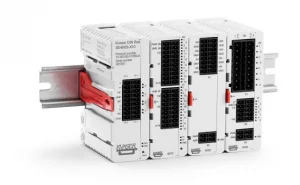Automotive endurance testing creates 100,000s of hours of test data per vehicle. Kvaser’s DIN Rail Ethernet to CAN/CAN FD interface and RA Consulting’s DiagRA D diagnostic software ensure reliable collection of diagnostic data on Audi’s test benches.
News
Stable, CAN communication modules ensure that Audi’s diagnostics data always gets through

The challenge:
In automotive endurance testing, whilst engineers are in physical proximity to oversee the test process, sufficient distance is required to isolate the engineers from the constant cycling of noise, vibration and harshness (NVH) tests that characterise the standard physical testing of new vehicles, along with crash behaviour and aerodynamics. As with most test systems, data collection and post-analysis are rarely carried out in the same place, but endurance tests require a particular combination of guaranteed real-time data acquisition and reliability when connecting the two locations.
Explained Patrick Guhl, responsible for vehicle measurement technology and test bench automation for vehicle emissions, consumption and range testing in the Audi test facility in Neckarsulm:
“We were looking for a CAN FD-capable module that could reliably bridge a distance of up to 100 metres between the vehicle on a test bench and the computer on which the DiagRA D diagnostic software is operated. The module needed to ensure a stable connection, with no interruptions in communication between the tool to access the car’s diagnostics data and the PC.” An important additional requirement was an independent connection after voltage drops or computer restarts.

The solution:
As a long-term user of DiagRA D diagnostic software to collect CAN and CAN FD data, Audi’s endurance test team turned to RA Consulting for advice on a bridging solution. RA Consulting (RAC), a Kvaser technical associate, had tested Kvaser’s recently-launched DIN Rail SE400S-X10, a multichannel, programmable Ethernet to CAN/CAN FD interface for DIN Rail mounting. The SE400S-X10 uses Kvaser’s standard universal driver, enabling RAC to guarantee a future-proof integration between their DiagRA D software and Kvaser’s DIN Rail series.
Commented Mario Hoppe, marketing and sales manager at RAC: “Whilst Wi-Fi and Bluetooth are fast enough to transmit data in many test scenarios, the long distances involved, building layout and environmental conditions would have made them unsuitable in this instance. The DIN Rail SE400S-X10 proved a versatile alternative, with programmable Ethernet to four CAN/CAN FD channels and all major CAN protocol types supported. Ethernet cabling also made it simple to assign many DIN Rail modules to their respective test benches.”
Audi was able to source software and hardware from one source, with a central contact person for questions and support. Noted Guhl: “The DIN Rail SE400S-X10 promised low installation effort, as it was voltage, LAN and OBD ready, and it’s top-hat rail mounted form-factor meant that it could be easily integrated into existing systems.”
With tests running 24/7 across a bank of dynamometers in Audi’s Neckarsulm and Ingolstadt test facilities, Kvaser’s DIN Rail SE400S-X10 ensures that CAN/CAN-FD data is gathered reliably from Audi’s test subjects. RA Consulting’s DiagRA D software combines this data and uses OEM specific diagnostic routines for data collection and troubleshooting. With DiagRA D’s advanced developer functionality and firmware updateability in Kvaser’s DIN Rail modules, the system can evolve as new features are added or Audi’s diagnostics testing needs change.
 linkedin
linkedin twitter
twitter youtube
youtube youku
youku weixin
weixin